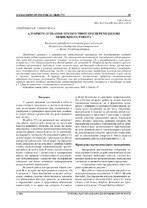| dc.contributor.author | Сидоренко, А. В. | |
| dc.contributor.author | Солодухо, Н. А. | |
| dc.coverage.spatial | Минск | ru |
| dc.date.accessioned | 2024-12-27T10:28:54Z | |
| dc.date.available | 2024-12-27T10:28:54Z | |
| dc.date.issued | 2024 | |
| dc.identifier.citation | Сидоренко, А. В. Алгоритм огибания препятствий при перемещении мобильного робота = Obstacle avoidance algorithm in mobile robot motion / А. В. Сидоренко, Н. А. Солодухо // Системный анализ и прикладная информатика. – 2024. – № 4. – С. 29-33. | ru |
| dc.identifier.uri | https://rep.bntu.by/handle/data/151585 | |
| dc.description.abstract | Предложен алгоритм и разработана компьютерная программа для моделирования огибания препятствий роботизированной системой. Для расширения возможностей перемещений роботизированной системой алгоритм совмещает основные элементы алгоритма vfh и разработанного нами ранее алгоритма I [1] и позиционируется в данной работе как алгоритм II. Проведена оценка среднего времени огибания препятствий различного типа, включая пять препятствий кубического типа, препятствие в виде длинной стены и сложное препятствие. В процессе вычислительного эксперимента с использованием симуляционного пространства Gazebo 11 рассчитаны временные параметры перемещения роботом препятствий различного типа, включая пять препятствий кубического типа, препятствие в виде стены и сложное препятствие. В процесс вычислительного эксперимента проведена статистическая обработка полученных результатов. Показано, что при использовании предложенного алгоритма оценка среднего времени огибания препятствий роботизированной системой снижается в отдельных случаях в 7,2 раза по сравнению с использованием алгоритма I. | ru |
| dc.language.iso | ru | ru |
| dc.publisher | БНТУ | ru |
| dc.title | Алгоритм огибания препятствий при перемещении мобильного робота | ru |
| dc.title.alternative | Obstacle avoidance algorithm in mobile robot motion | ru |
| dc.type | Article | ru |
| dc.identifier.doi | 10.21122/2309-4923-2024-4-29-33 | |
| local.description.annotation | A method has been proposed, and a computer program has been developed for simulating obstacle avoidance by a robotic system. To expand the mobility capabilities of the robotic system, the algorithm combines the core elements of the vfh algorithm and our previously developed algorithm I [1], and is positioned in this work as algorithm II. An evaluation of the average obstacle avoidance time for various types of obstacles has been conducted, including five cubic obstacles, a long wall obstacle, and a complex obstacle. During the computational experiment using the Gazebo 11 simulation environment, the time parameters for robot movements around various types of obstacles were calculated, including five cubic obstacles, a wall obstacle, and a complex obstacle. In the computational experiment, statistical processing of the obtained results was carried out. It was shown that using the proposed algorithm, the assessment of the average time for the robotic system to avoid obstacles is reduced in some cases by up to 7.2 times compared to the use of algorithm I. | ru |

